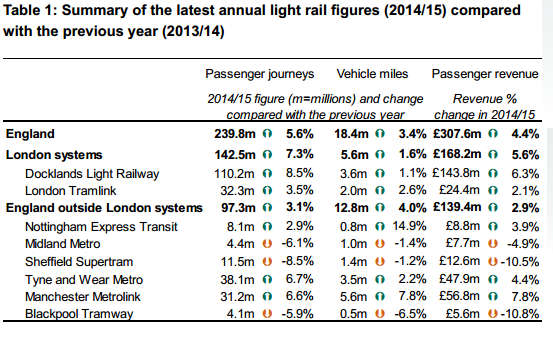Light rail usage in England has risen to its highest level since records began in 1983, driven by a continuing rapid expansion in London, according to the latest government statistics.
As a consequence revenue increased by 4.4% in real terms to £307.6m in 2014/15 compared with 2013/14, despite average revenue per journey decreasing by 1.5 pence (1.2%) in real terms to 128 pence.
A Department for Transport (DfT) data release this week covered the eight light rail systems in England including the Docklands Light railway, London Tramlink, Nottingham Express Transit, Midland Metro, Sheffield Supertram, Tyne and Wear Metro, Manchester Metrolink and the Blackpool Tramway.

In 2014/15, 239.8 million passengers journeys were made on the eight light rail and tram systems in England, a 5.6% increase on the previous year. This was mainly the result of the increase of journeys in London which has seen a 97.6% rise in passenger since 2004/05.
In England outside London there has been a 12.4% increase in passenger journeys over the last 10 years.
Declining numbers in Blackpool, Midlands and Sheffield have been counteracted by increases elsewhere outside of London.
Network expansions in Manchester – such as the connection to Manchester Airport, which opened on 3 November 2014 adding 15 stops and 9 route miles - helped deliver a 6.6% increase in Metrolink passenger journeys last year, while the Tyne and Wear Metro saw a 6.7% increase.
There has also been an increase in vehicle mileage in London of 59% in the last 10 years to 5.6 million miles, whereas mileage outside London has increased by 29% to 12.8 million miles.
Satisfaction levels were high across England with overall satisfaction at 90%, ranging from 85% on Manchester Metrolink to 96% in Nottingham - higher than both the National Rail Passenger Survey (81%) and Bus Passenger Survey (88%).
However the DfT points out that value for money satisfaction (61%) was at a similar level to bus passengers (63%) although much higher than rail passengers (46%) in 2014.
Concessionary travel levels were also in stark contrast to bus levels, with 12% of all light rail passenger journeys concessionary, compared to 34% on buses.
Concessionary journeys actually declined as a share of all passenger journey by 1% from 2013/14, although this is mainly due to an 80% reduction in concessionary passenger journeys in Blackpool due to concessions being restricted to Blackpool Borough residents only.
Midlands Metro and Sheffield Supertram services were affected by engineering works and restricted services over the last financial year.